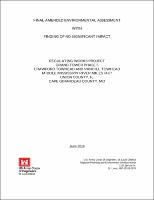Please use this identifier to cite or link to this item:
https://hdl.handle.net/11681/47927| Title: | Final Amended Environmental Assessment with Finding of No Significant Impact : Regulating Works Project, Grand Tower Phase 5, Crawford Towhead and Vancill Towhead, Middle Mississippi River MIles 74-67, Union County, IL, Cape Girardeau County, MO |
| Authors: | United States. Army. Corps of Engineers. St. Louis District |
| Keywords: | Mississippi River Inland navigation Environmental management Hydrology Hydrology Hydraulic structures |
| Publisher: | United States. Army. Corps of Engineers. St. Louis District. |
| Abstract: | The Congress of the United States, through the enactment of a series of Rivers and Harbors Acts beginning in 1824, authorized the Secretary of the Army, by and through the U.S. Army Corps of Engineers St. Louis District (District), to provide a safe and dependable navigation channel, currently 9 feet deep and not less than 300 feet wide, with additional width in the bends as required, on the Middle Mississippi River (MMR).1 The MMR is defined as that portion of the Mississippi River that lies between its confluence with the Ohio and the Missouri rivers (hereinafter referred to as the Project; Figure 1). This ongoing Project is also commonly referred to as the Regulating Works Project. The Regulating Works Project utilizes bank stabilization and sediment management to maintain bank stability and ensure adequate navigation depth and width. Bank stabilization is achieved by revetments, while sediment management is achieved by river training structures, i.e. dikes. Other activities performed to obtain the navigation channel are rock removal and construction dredging. The Project is maintained through dredging and any needed maintenance to already constructed features. Therefore, both regulating works structures and dredging are all part of the overall Regulating Works Project. The long-term goal of the Project, as authorized by Congress, is to provide a sustainable and safe navigation channel and reduce federal expenditures by alleviating the amount of annual maintenance dredging and the occurrence of vessel accidents through the construction of regulating works. Therefore, pursuant to the Congressionally authorized purpose of the Project, the District continually monitors areas of the MMR that require frequent and costly dredging to determine if a long-term sustainable solution through regulating works is reasonable. To the extent possible under existing authorities, environmental laws, regulations, and policies, the District considers the environmental consequences of its activities as it constructs and operates the Project and acts accordingly. An important component of each activity is the use of scientific, economic, and social knowledge to understand the environmental context and effects of District actions in a collaborative manner, employing an open, transparent process that respects the views of Federal and State stakeholders, individuals, and groups interested in District activities. Frequent dredging has been required in the area of the proposed Regulating Works, Grand Tower Phase 5 construction work area (Grand Tower Phase 5 work area; see a detailed discussion of this in Section 3, Affected Environment.) Therefore, after analysis of this area, the District concluded that construction of the Grand Tower Phase 5 work area is reasonable and necessary to address the repetitive channel maintenance dredging in order to provide a sustainable, less costly navigation channel in this area. The District has concluded through analysis and modeling that construction of river training structures and revetment would provide a sustainable alternative to repetitive maintenance dredging. Construction is expected to begin in 2016 or 2017. The planning of specific construction areas, including the Grand Tower Phase 5 work area, requires extensive coordination with resource agency partners and the navigation industry. The U.S. Fish and Wildlife Service (USFWS), Missouri Department of Conservation (MDC), Illinois Department of Natural Resources (IDNR), and multiple navigation industry groups were included in the planning of the Grand Tower Phase 5 work area and provided comments related to navigation industry concerns and environmental resources issues, as documented in Technical Report M62, Vancill Towhead HSR MODEL, River Miles 72.00 – 65.00, Hydraulic Sediment Response Model Investigation. |
| Description: | Environmental Assessment with Finding of No Significant Impact |
| Rights: | Approved for Public Release; Distribution is Unlimited |
| URI: | https://hdl.handle.net/11681/47927 |
| Appears in Collections: | Environmental Documents |
Files in This Item:
| File | Description | Size | Format | |
|---|---|---|---|---|
| Regulating Works Project - Grand Tower Phase 5 - EA and FONSI_2016.pdf | 19.13 MB | Adobe PDF |  View/Open |